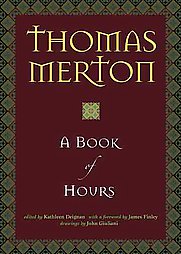Sacred Reading
 If someone had mentioned “sacred reading” to me before this week, I would have assumed they meant a literary genre — a category of books focused on sacred topics.
If someone had mentioned “sacred reading” to me before this week, I would have assumed they meant a literary genre — a category of books focused on sacred topics.
But since delving into Thomas Merton’s Book of Hours, I’ve come to a different understanding. Or maybe it’s that Kathleen Deignan’s use of the term in her introduction to Thomas Merton’s thought supplies the label for something I’ve known in a groping, incompletely conceived way — something both my “25 Reasons to Read” page and my blog tagline by Muriel Rukeyser gesture toward, but don’t fully capture. I wanted to quote some passages from Deignan’s explanation of sacred reading, passages I’m sure to be musing over for some time to come.
Merton wrote that “the pleasure of reading and writing poetry… ‘helps me Godward’.” Deignan explains,
Extraordinary literary artist that he was, Thomas Merton had a remarkable capacity for lectio divina — sacred reading, or reading a text in a sacred way. Practiced by all religious traditions that prize their scriptures, the art of lectio divina is the very foundation of our experience of worship and its reverberation in the silence of contemplative life. But the scope of lectio is wide and deep, because the nature of the word is the same. Merton knew well that the Word of God is not only being uttered in the sacred scriptures, but more primordially in creation, more existentially in history, more imaginatively in works of art, more immediately and personally in human experience. Because he understood the dimensionality of the Word of God he understood how to read it in all its myriad forms…
How necessary, then, to learn to read the revelatory texts of scripture, sunsets, heartbreaks, aesthetic works, benedictions and catastrophe, prose and prophecy, and all the other miraculous and perplexing “words of God” endlessly being storied forth for our deep reading. They all invite our skillful practice of the Christian art lectio divina, one of the primary modalities of Christian transformation that brings us, in both our waking and our dreaming, to the wellsprings of contemplation, the ground of the life of praise.
I wouldn’t pretend to really grasp all that I read in this little book. It gathers excerpts of Thomas Merton’s writing and arranges them as prayers at dawn, midday, dusk and evening. There are seven days worth of prayers, and I can imagine returning to this book many times.
The main purpose of a book of hours is to remind us to simply stop, to swerve out of the noise of life for a few moments at regular intervals during the day and to reorient — to aim our souls toward God. Probably the most revelatory thing about the book for me is that it showed me how difficult this is for me to do. I’ve long valued my morning time with the Lord, but to find four times during the day — even brief ones — during which I can stand aside and compose myself before him is very, very difficult.
“But we’re supposed to pray without ceasing,” I can imagine someone saying. “Can’t we shoot up prayers in the midst of living all day long? Why should we have to pull the car over and stop for a few minutes?” Well, sure. I’m an expert at such toss-ups. But all I can say is that we’re creatures of body as well as of soul, and if I make my body stop and kneel, or go “into the closet and close the door” (as Jesus put it), my mind and heart are more likely to follow.
There are some aspects of the contemplative life that I relate to, and some that I don’t understand. But I appreciated having this book on hand. This, combined with Os Guinness’ Prophetic Untimeliness, has made me very aware of the noise level of life and of the church. One of these days I’ll have a post ready on it.





4 Comments
Ruth
That is an amazing quote. Great post, as always.
DebD
It sounds like a lovely and encouraging book. I do have The Hours available to me and, still, I don’t take the time to stop and pray them. I have tried to be more disciplined but this does not come easily.
hopeinbrazil
Sounds like a fascinating book. Thanks for bringing it to our attention.
Pingback: